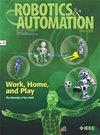Computer and Robot Vision: Past, Present, and Future [TC Spotlight]
IF 5.4
3区 计算机科学
Q1 AUTOMATION & CONTROL SYSTEMS
引用次数: 0
Abstract
Robot perception is the capability of a robot to estimate and understand its surroundings to the degree that enables it to navigate and interact with the environment. Right at the core of robot perception lies the problem of building an internal model of the robot’s surroundings using onboard sensor data and prior knowledge. Although the internal model of the environment can be purely geometric (e.g., a point cloud)—as in traditional simultaneous localization and mapping (SLAM)—it can also contain higher-level structures, such as objects and other semantic elements of the scene (e.g., buildings, roads, pedestrians). In this sense, robot perception is related to the topic of scene understanding in the computer vision literature. Due to its crucial role in enabling robotics applications, ranging from navigation to manipulation and human–robot interaction, robot perception has been at the center stage of robotics research for more than 50 years计算机和机器人视觉:过去、现在和未来 [TC 聚焦]
机器人感知能力是指机器人对周围环境的估计和理解能力,这种能力使机器人能够导航并与环境互动。机器人感知的核心问题是利用机载传感器数据和先验知识建立机器人周围环境的内部模型。虽然环境的内部模型可以是纯粹的几何模型(如点云)--如传统的同步定位和映射(SLAM)--但也可以包含更高层次的结构,如物体和场景中的其他语义元素(如建筑物、道路、行人)。从这个意义上说,机器人感知与计算机视觉文献中的场景理解主题相关。由于机器人感知在实现机器人应用(从导航到操纵和人机交互)方面发挥着至关重要的作用,50 多年来,机器人感知一直处于机器人研究的中心位置[1]。同样,自计算机视觉社区成立以来,感知一直是其核心课题[2]。
本文章由计算机程序翻译,如有差异,请以英文原文为准。
求助全文
约1分钟内获得全文
求助全文
来源期刊

IEEE Robotics & Automation Magazine
工程技术-机器人学
CiteScore
8.80
自引率
1.80%
发文量
100
审稿时长
>12 weeks
期刊介绍:
IEEE Robotics & Automation Magazine is a unique technology publication which is peer-reviewed, readable and substantive. The Magazine is a forum for articles which fall between the academic and theoretical orientation of scholarly journals and vendor sponsored trade publications. IEEE Transactions on Robotics and IEEE Transactions on Automation Science and Engineering publish advances in theory and experiment that underpin the science of robotics and automation. The Magazine complements these publications and seeks to present new scientific results to the practicing engineer through a focus on working systems and emphasizing creative solutions to real-world problems and highlighting implementation details. The Magazine publishes regular technical articles that undergo a peer review process overseen by the Magazine''s associate editors; special issues on important and emerging topics in which all articles are fully reviewed but managed by guest editors; tutorial articles written by leading experts in their field; and regular columns on topics including education, industry news, IEEE RAS news, technical and regional activity and a calendar of events.
 求助内容:
求助内容: 应助结果提醒方式:
应助结果提醒方式:


